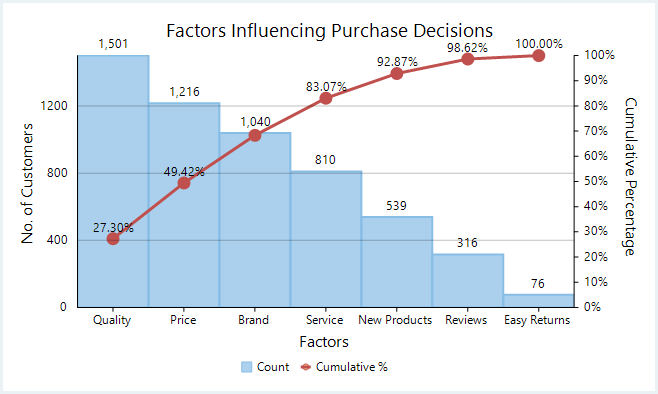
The 80/20 Rule? As an ASP or Jobber? – How it can help me?

First of all, what is the 80/20 Rule or otherwise known as the Pareto Principle?
The Pareto Principle in business refers to the way 80 percent of a given business’s profit typically comes from a mere 20 percent of its clientele.
Business owners who subscribe to the 80/20 rule know the best way to maximize results is to focus the most customer centric efforts on that top 20 percent. In other words, roughly 20 percent of your customer relation/satisfaction efforts delivers a yield of 80 percent of your overall results.
Understand that this isn’t to say that the other 80 percent isn’t important in either case.
The math may not always work out to exactly 80 percent versus 20 percent in every situation, but the Pareto Principle can still be taken as inevitable.
NEW - Inside Sales and Customer Service Online Training
96% of Consumers say Customer Service is an Important Factor in their Choice of Loyalty to a Brand
The Inside Sales and Customer Service Course from Excel Sales Consulting gives your inside sales team a practical, usable framework to give exceptional customer service. Perfect for both your newest team members and your veterans, this course breaks down what it means to give customers a memorable experience. When your team has the confidence to do all the little things right, there will be more sales and a more positive work culture.
More info click here!
How Does Understanding the 80/20 Rule Benefit My Business?
So now you know what the Pareto Principle is and how it can lend a deeper understanding of nearly any set of efforts versus their results. But what does that mean for your business? How can factoring the 80/20 rule into your business help you take your results to the next level?
You can significantly boost your profits by...
Once you understand that 20 percent of your sales reps generate 80 percent of your profits, you’re in a position to refocus your management efforts to the benefit of your business.
Use what you know to help the top 20 percent hone their exceptional skills even further and train the remaining 80 percent to operate more like your highest achievers.
#1) 80/20 rule with regards to your sales team, it is a common occurrence in any business that roughly 20% of your salesmen produce 80% of your sales. Depending on your end goals, the Pareto Principle can be utilised to determine whether you need to focus your effort and resources on the 20% of staff that produce most of your sales to further improve their skills or to focus on the 80% of other employees that are struggling to bring in any sales.
#2) 80/20 rule with regards to your products and services, similarly, only a handful of your products and/or services attract the most sales. As such, analyzing the leads and current customers you have can help you determine which ones have produced the most revenue in the past so that you can focus on pursuing only the most valuable leads. Further, discontinuing the products/services that don’t generate revenue and focusing on improving the ones that do can be ultimately more beneficial for the business.
#3) 80/20 rule in identifying and fixing problems, a Pareto chart is highly useful for prioritizing problems so that you can determine which issues have the greatest effect on the outcome of a given situation. This not only allows you to identify problems, but it also enables you to take appropriate actions to resolve the most important issues concerning your business.
The appearance of a Pareto chart is quite straight forward with vertical bars plotted in decreasing order in relevance to their relative frequencies. The higher the frequency, the greater the impact it will have on your business – so, it is crystal clear where you need to focus your attention on to improve your business. The Pareto chart is an excellent way to pinpoint the issues affecting your sales, productivity and overall success of the business.

You’ll see your team’s overall productivity level skyrocket, taking your profits right along with it.
The 80/20 rule can be used to help team members of every level stop squandering their efforts on trivial tasks that don’t help them or the company meet larger goals.
#4) 80/20 rule in developing your customer care strategy, customer support is a crucial aspect of any business so it is prudent to ensure that your customers are satisfied with the customer service they receive. The Pareto Principle indicates that 80% of customer complaints are related to 20% of your products/services, so a proper analysis of which products/services are causing problems for your business can help you to permanently sort out customer service issues. Also, by utilising the 80/20 rule you can identify which particular customer service staff is associated to the majority of customer complaints so that you can focus on altering the way in which the associated staff interact with customers.
The Pareto Principle is not a method to completely eliminate the non-critical aspect of any given situation; rather, it is a simple phenomenon that allows us to shift our focus on the areas that will have the most profound impact on the end goal and will yield the greatest results. It is particularly useful for businesses as it allows you to identify which aspects of your business are not performing to their full potential and thus makes it easier for you to focus on the issues that require the most urgent attention. The most successful businesses utilise the Pareto Principle to ensure that all operations conducted within the business are contributing to the overall success of the business.
